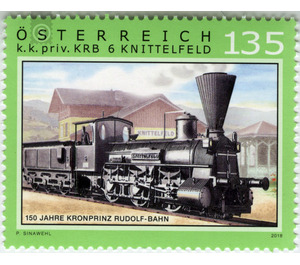150 years of the Rudolf railway - Austria / II. Republic of Austria 2018 - 135 Euro Cent
Theme: Traffic, Transportation & Mobility
| Country | Austria / II. Republic of Austria |
| Issue Date | 2018 |
| Face Value | 135.00 |
| Edition Issued | 250,000 |
| Color | green |
| Printing Type | offset |
| Stamp Type | Commemorative |
| Item Type | Stamp |
| SID | 672436 |
| Dimensions | 42.00 |
| In 117 Wishlists | |
150 years of the Rudolf Railway The route to the south This stamp to commemorate an anniversary is dedicated to the third railway line to traverse the Austrian Alps after the Southern Railway over the Semmering Pass and the Brenner Railway in the west. The railway from St. Valentin to Tarvisio, also known as the Rudolf Railway, was intended to connect the centres of the iron industry in Upper Austria, Styria and Carinthia to the Southern Railway, which ran from Vienna to Trieste. The intention was to divert transitory traffic from Germany and Bohemia to the Rudolf Railway via additional access routes in order to increase utilisation. The newly founded “k. k. priv. Kronprinz Rudolf-Bahn Gesellschaft” (Imperial and Royal privileged company of the Crown Prince Rudolf railway), or KRB for short, was granted a concession to build the railway. The planner, the engineer Franz Kazda, adapted the route to match the terrain, and took it through the valleys and over the Schober Pass, the lowest crossing over the Alpine ridge. On 15th August 1868 the first section of the route from St. Valentin to Steyr was finally opened. A continuous journey, lasting 14 hours, along the full 407 kilometres to Tarvisio became possible from 1873 on. However, a connection to the privatised Southern Railway company was not established due to objections by the latter. The economic conditions meant that the hoped-for transport levels were never achieved, as a result of which the Rudolf Railway was subsequently nationalised in 1884. Today it is part of the Austrian national railway network. The Rudolf Railway The KRB’s 114 locomotives were mostly manufactured in Austria. The engines for passenger trains were allocated odd numbers; those for goods trains, even ones. The commemorative stamp shows the KRB 6 Knittelfeld, one of the oldest goods trains operated by the KRB. The stations were all equipped with an electric telegraph, with manned stations having bells connected via their own network. The signals and barriers were operated by means of hoists. The route runs via Steyr to Hieflau, through the Gesäuse Valley to Selzthal, over the Schober Pass and through the Mur Valley to Knittelfeld and Judenburg. From here it crosses the Neumarkter Sattel (mountain saddle) to Carinthia, continuing via St. Veit an der Glan to Villach and ultimately to Tarvisio, which is now in Italy


